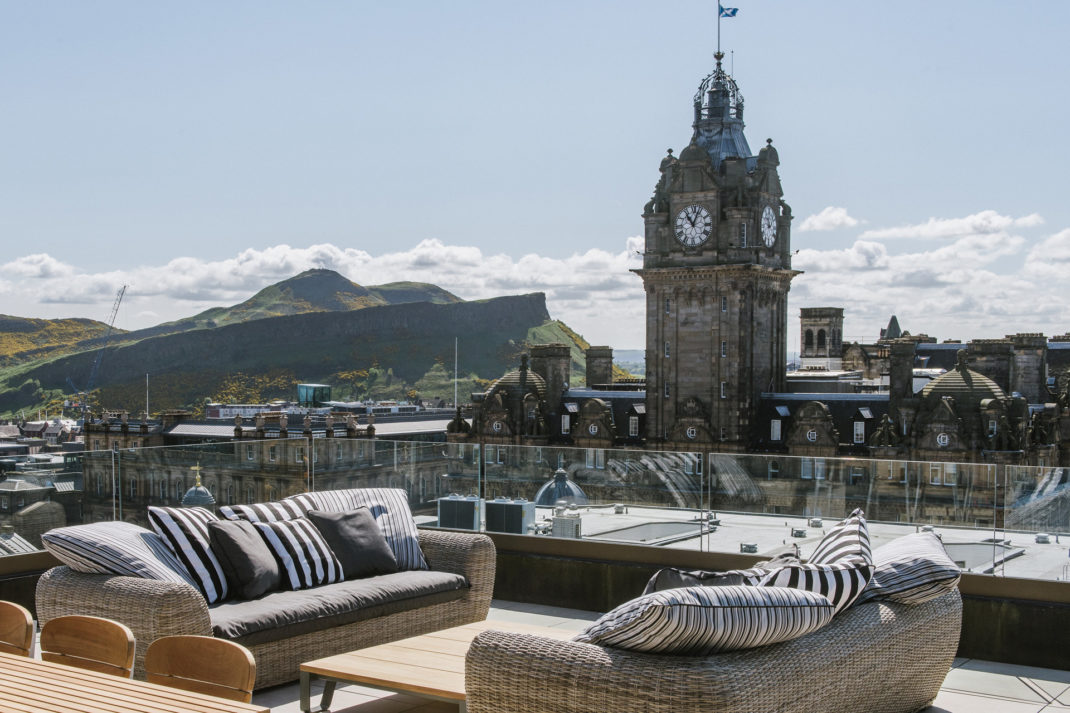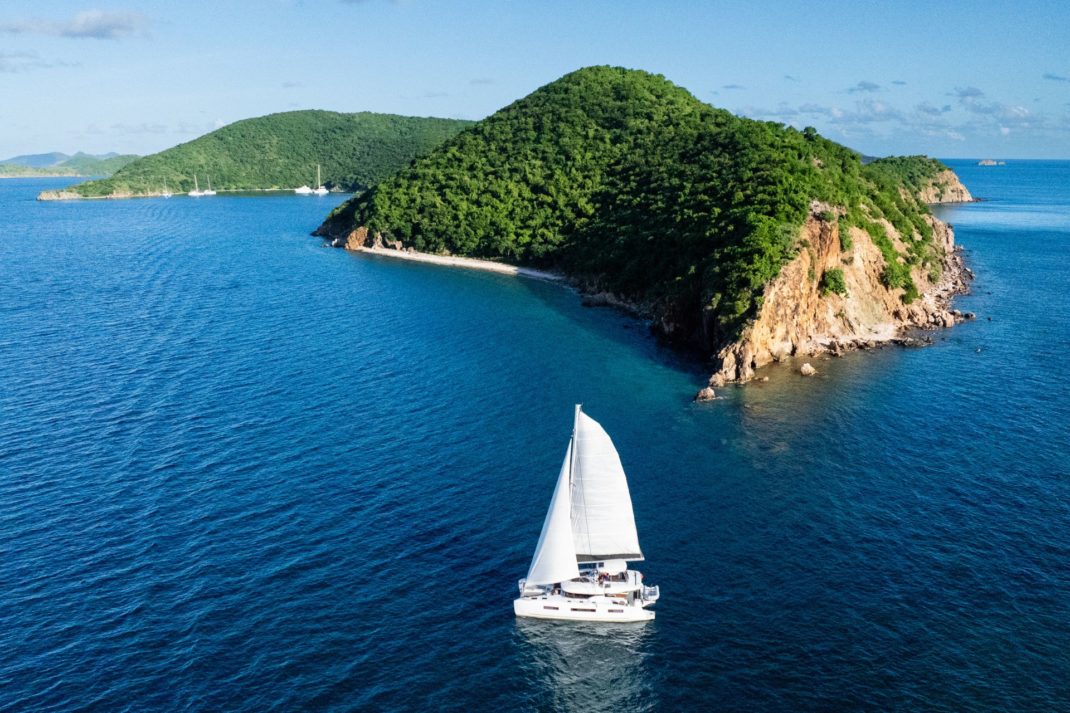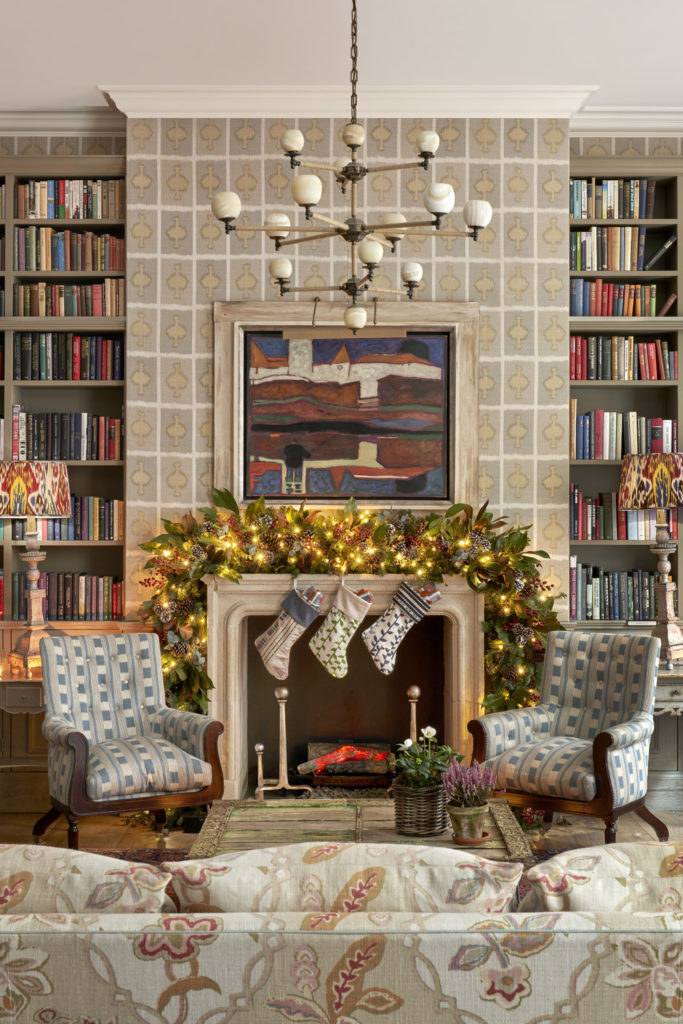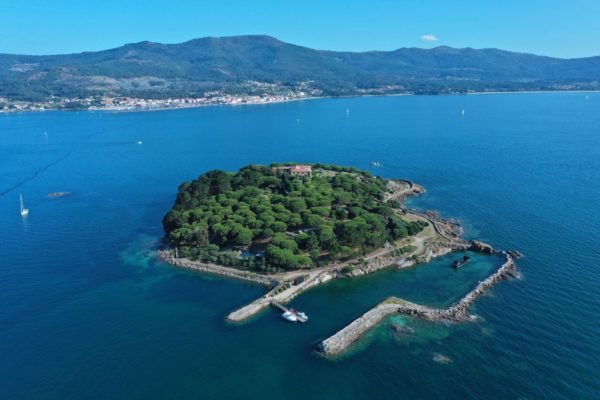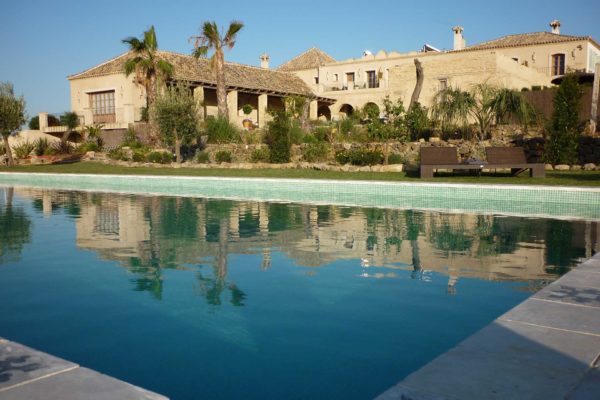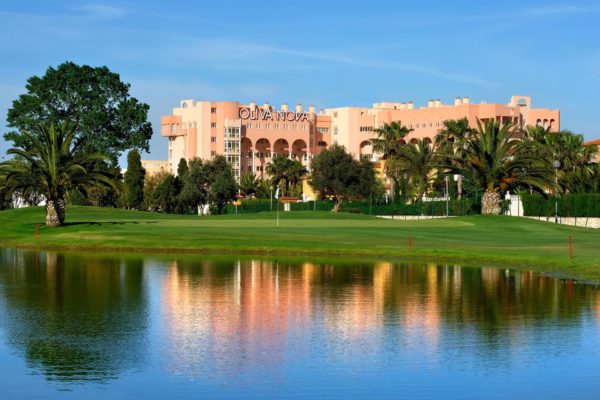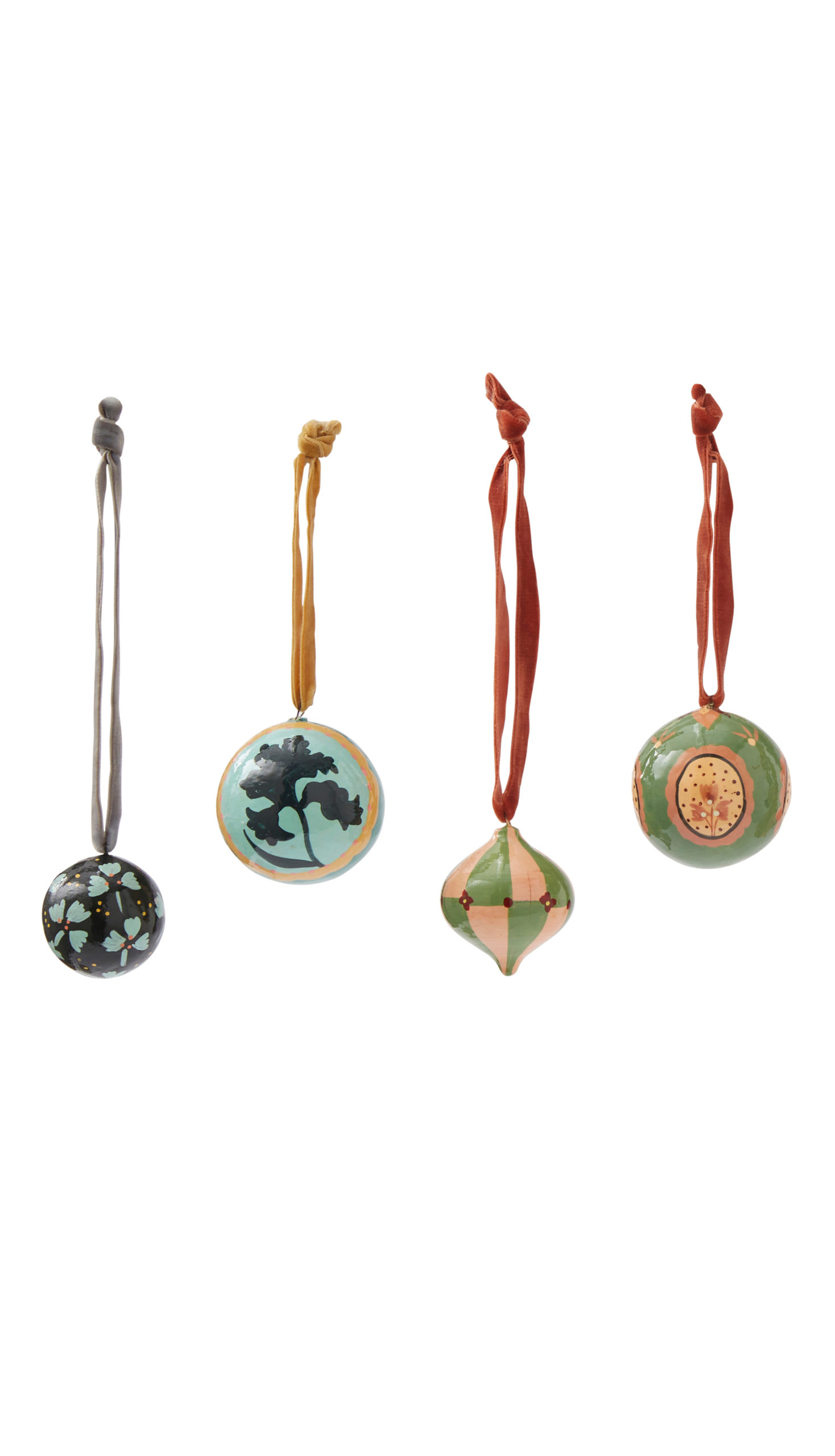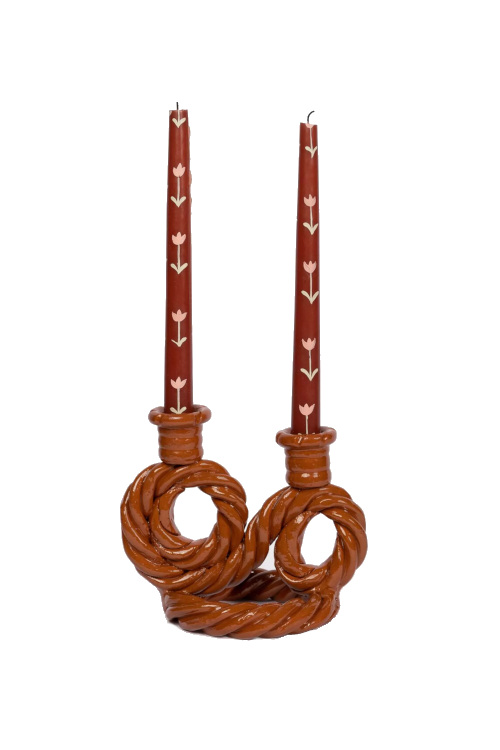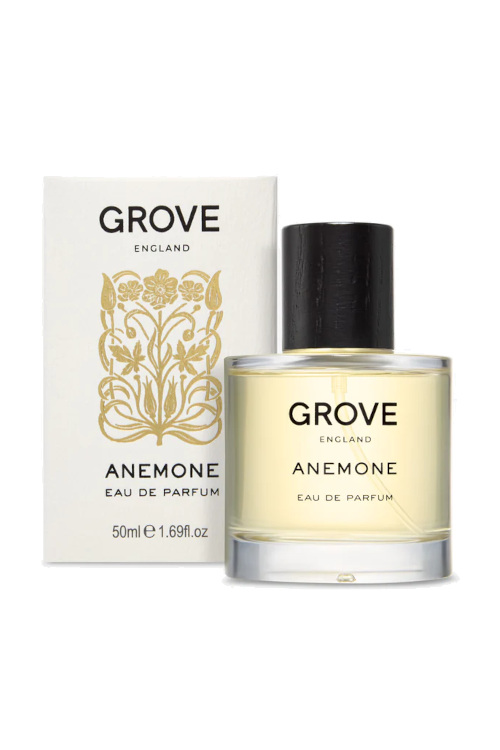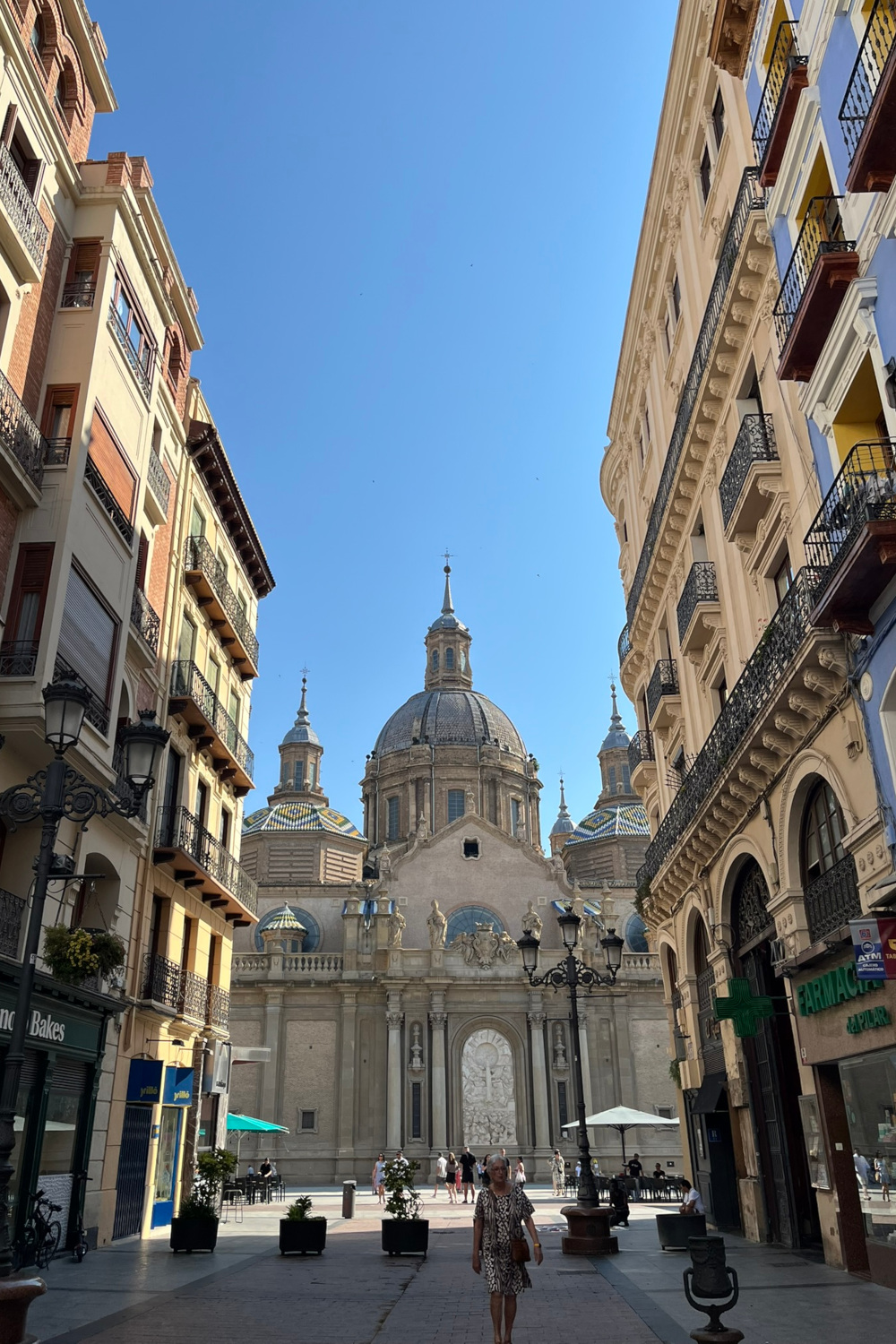
Touring Through Spain’s Wine Country: How To Holiday In Aragon
By
3 months ago
A detailed guide of what to do, see and eat in the Spanish region
If there’s one country us Brits never get tired of visiting, it’s Spain. Of all the places holidaymakers could think to go in Europe, none have the same far-reaching, cross-generational appeal. Families head to Tenerife’s water parks, teens plan gap year activities around Ibiza and Mallorca, friend groups spend weekends in Barcelona and Madrid, and couples of all ages slip off to Seville and Granada for a romantic getaway.
That is to say: Spain pretty much has it all. And while concerns around overtourism may have peaked this year, it’s certainly not the end of the great Spanish holiday. Rather than consider it a sign to change course completely, now’s the best time to look beyond the country’s postcard-popular cities.
That’s where Charlie Colville’s next trip to Spain takes her; beyond the big cities and crowded coastlines, she finds a slice of authenticity in Aragon, a northeastern region with a rich history (and even richer wine industry).
Exploring Aragon: Zaragoza, Huesca & The Almighty Wine Trail
DO
Our journey starts in Zaragoza, the capital of Aragon. With a legacy dating back over 2,000 years, this is a city with a richly layered culture – and plenty of stories to tell. The area has been held by several pairs of hands over the centuries – the Romans, the Visigoths, the Moors and, eventually, the Christians – making it a true melting pot of cultures, ones that have made Spain what it is today.
It makes sense then that we kick off our tourist activities with a trip to two of Zaragoza’s major heritage points: the Cathedral-Basilica of Our Lady of the Pillar and the Cathedral of the Savior of Zaragoza. The city’s co-cathedrals are located less than a five minute walk from each other, with the former sitting on the Plaza del Pilar and the latter nearby on the Plaza de la Seo.
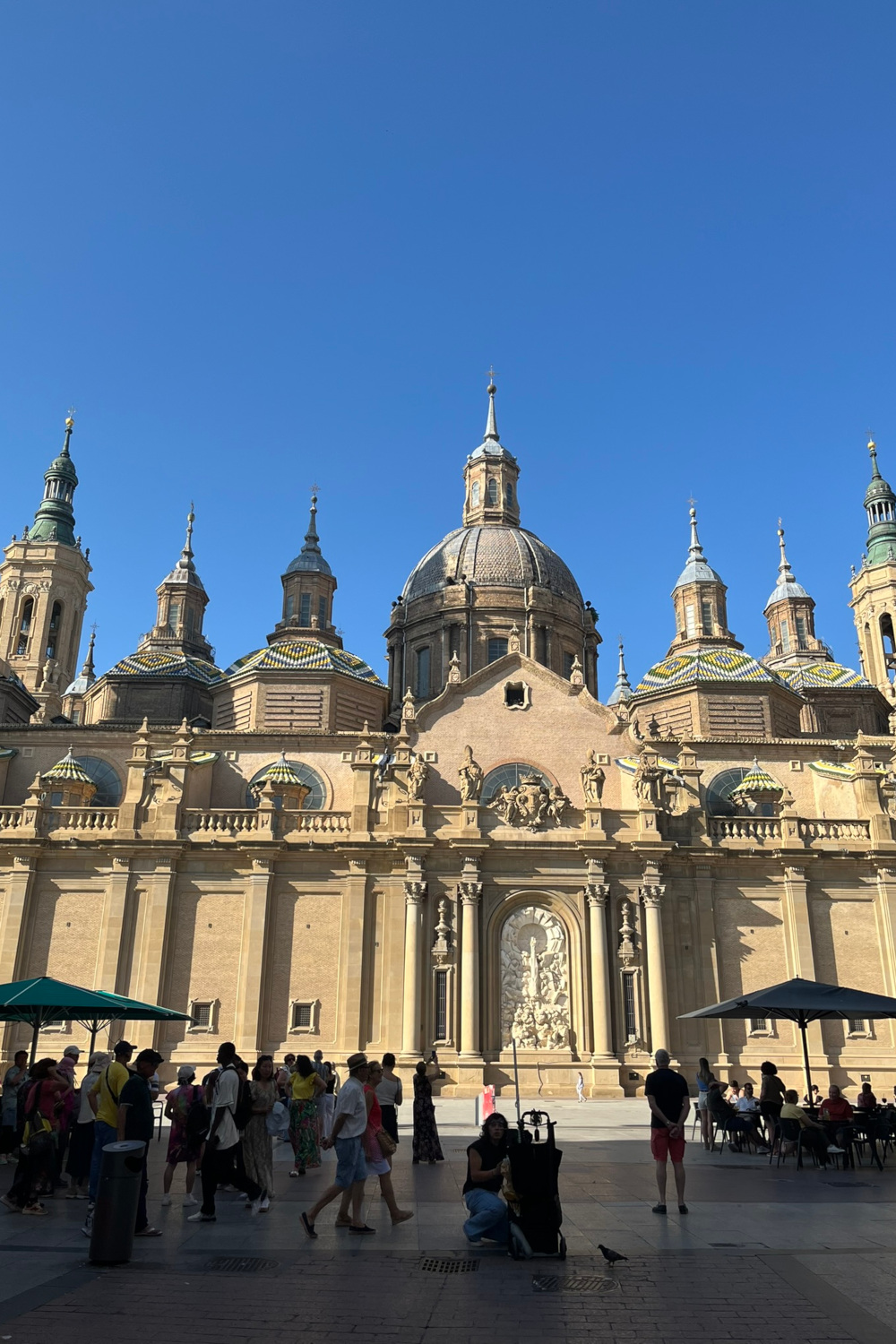
Cathedral-Basilica of Our Lady of the Pillar is one of Zaragoza’s most ornate structures
The Cathedral-Basilica of Our Lady of the Pillar – named for the story of how Mary appeared to Saint James with a column of jasper, and instructed him to build a church in her honour – is an imposing Baroque structure. (The facade as we see it now was envisioned in the late 17th century, but the building has served multiple lives in Romanesque, Gothic and Mudéjar styles.) And inside, it’s just as beautiful: marble floors, richly ornamented surfaces and towering vaulted ceilings painted with frescos by artist Francisco Goya.
(And, if you fancy seeing the city from an aerial vantage, you can head round to the cathedral’s entrance on the River Erbo to take a trip up one of the towers. Soaring up via a lift, you’ll have a great view of the river, the nearby plaza and the rooftops of Zaragoza.)
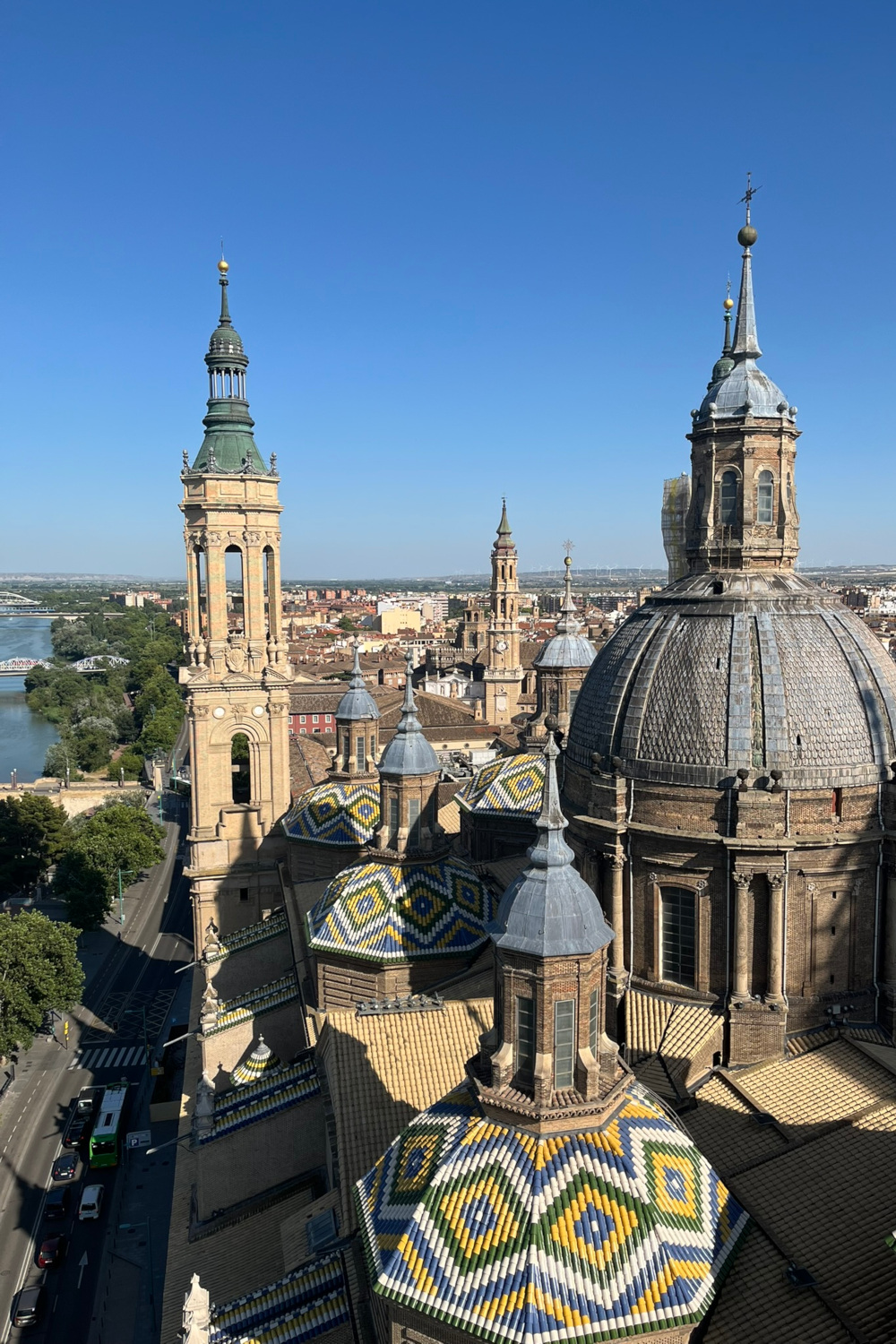
The view from the top of the lift
The Cathedral of the Savior of Zaragoza, meanwhile, features a different patchwork of architectural styles. The space forms part of the old Roman forum, with the oldest parts of the current building dating back to the 11th century, when Zaragoza was still under Islamic rule. And when power was eventually transferred to the Christian kings of Spain, the mosque wasn’t demolished – instead, the building was consecrated under the new faith and renovated over the subsequent centuries to also include Romanesque, Gothic-Mudéjar and Renaissance styles.
While the cathedral has undergone numerous changes and restorations, you can still catch glimpses of some of the older architectural elements – such as the exterior wall of the Parroquieta, where you can find a geometric grid design in the Aragonese Mudéjar style.
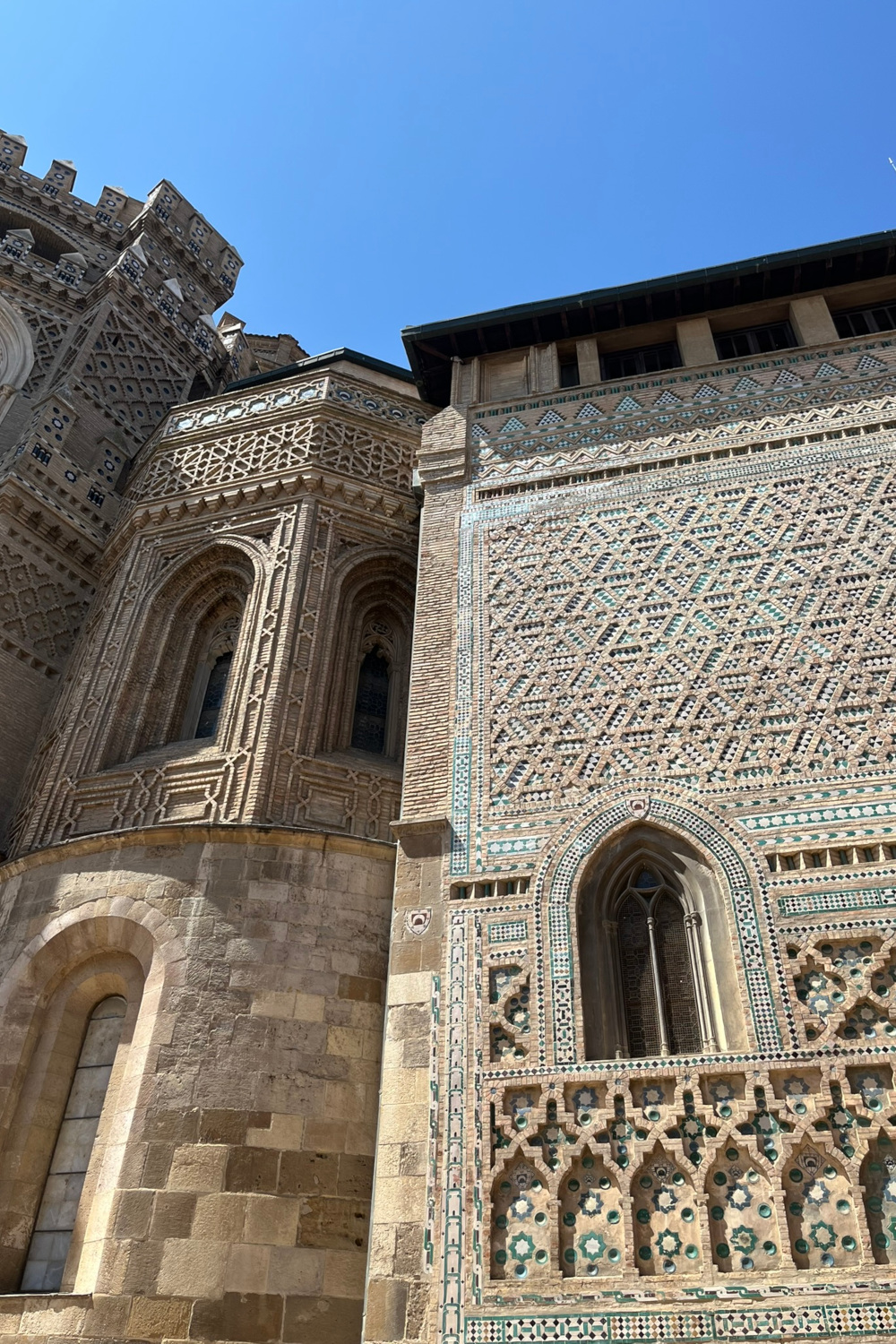
Aragonese Mudéjar architecture on the side of the Cathedral of the Savior of Zaragoza
It’s also worth adventuring slightly outside the city centre, to the Aljafería Palace. A UNESCO World Heritage Site, the palace is steeped in history. Built in the 11th century when the area still formed an independent Arab Muslim state, the palace was home to the Banu Hud dynasty and, later, the Christian kings of Aragon, who eventually converted it into a military fortress (complete with moat and imposing facade).
But to this day, it showcases some of the best-preserved Spanish Islamic architecture in the world – seen in the Moorish-taifa arches, geometric latticework and even the palace layout itself (which was modelled after 8th century desert castles in Syria and Jordan).
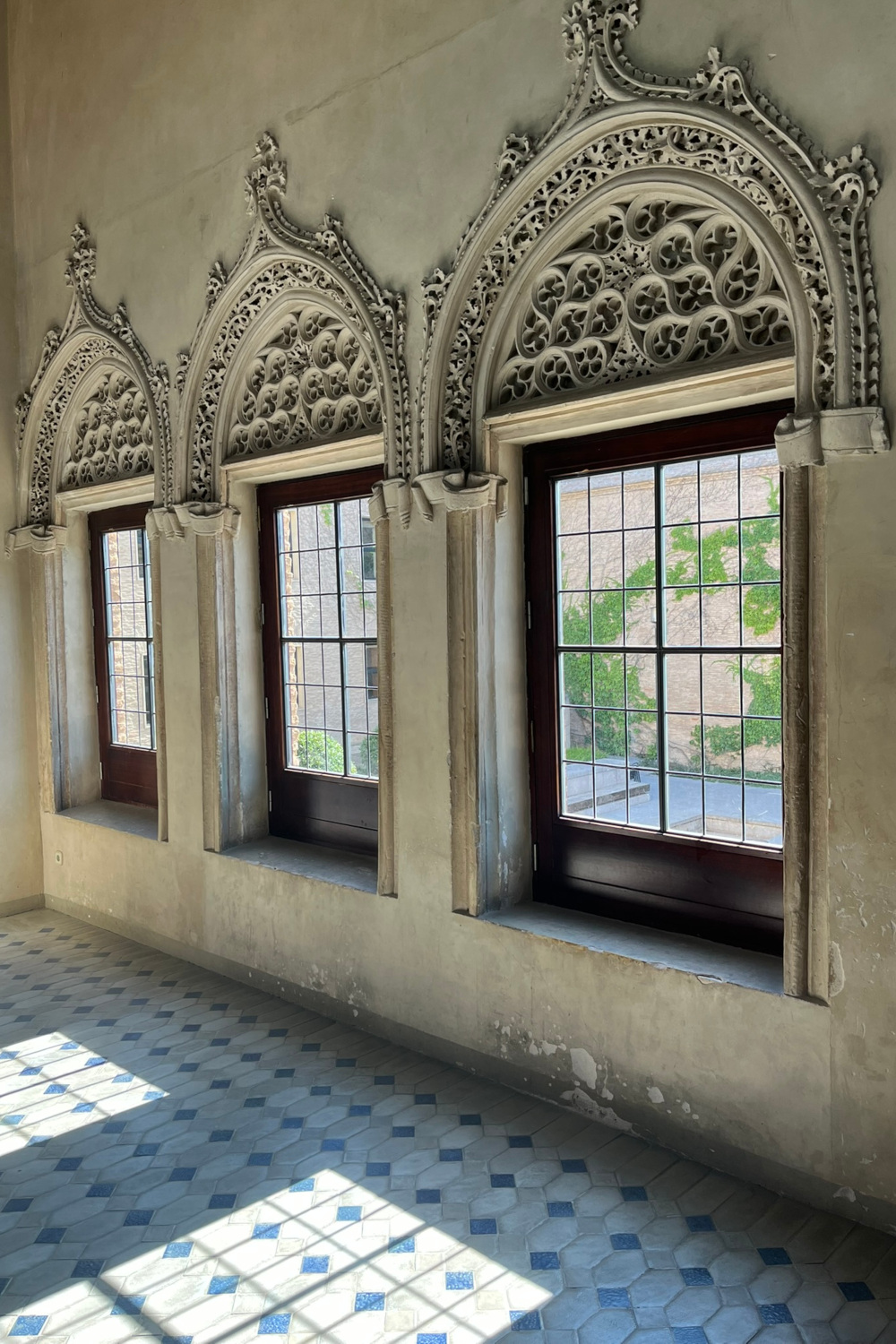
Examples of Moorish-taifa arches at the Aljafería Palace
Art historians will also be pleased to find out that Aragon is the home of Francisco de Goya, one of the 19th and 20th century’s most prolific romantic painters. The artist was born in Fuendetodos, a small town about 40 minutes away from Zaragoza – and the city still celebrates his legacy to this day.
The main attraction is the official Museo Goya, which houses a permanent collection of prints created by the artist throughout his career. Spanning 1728 all the way through to 1825, you’ll find some of Goya’s key works: The Follies, The Disasters of War, Bulls of Bodeaux and more. (The museum is currently shut for renovations – with a grand reopening slated for 2026 – but visitors to Zaragoza can catch a glimpse of his works in the meantime at the Aljafería Palace with a main entrance ticket.)
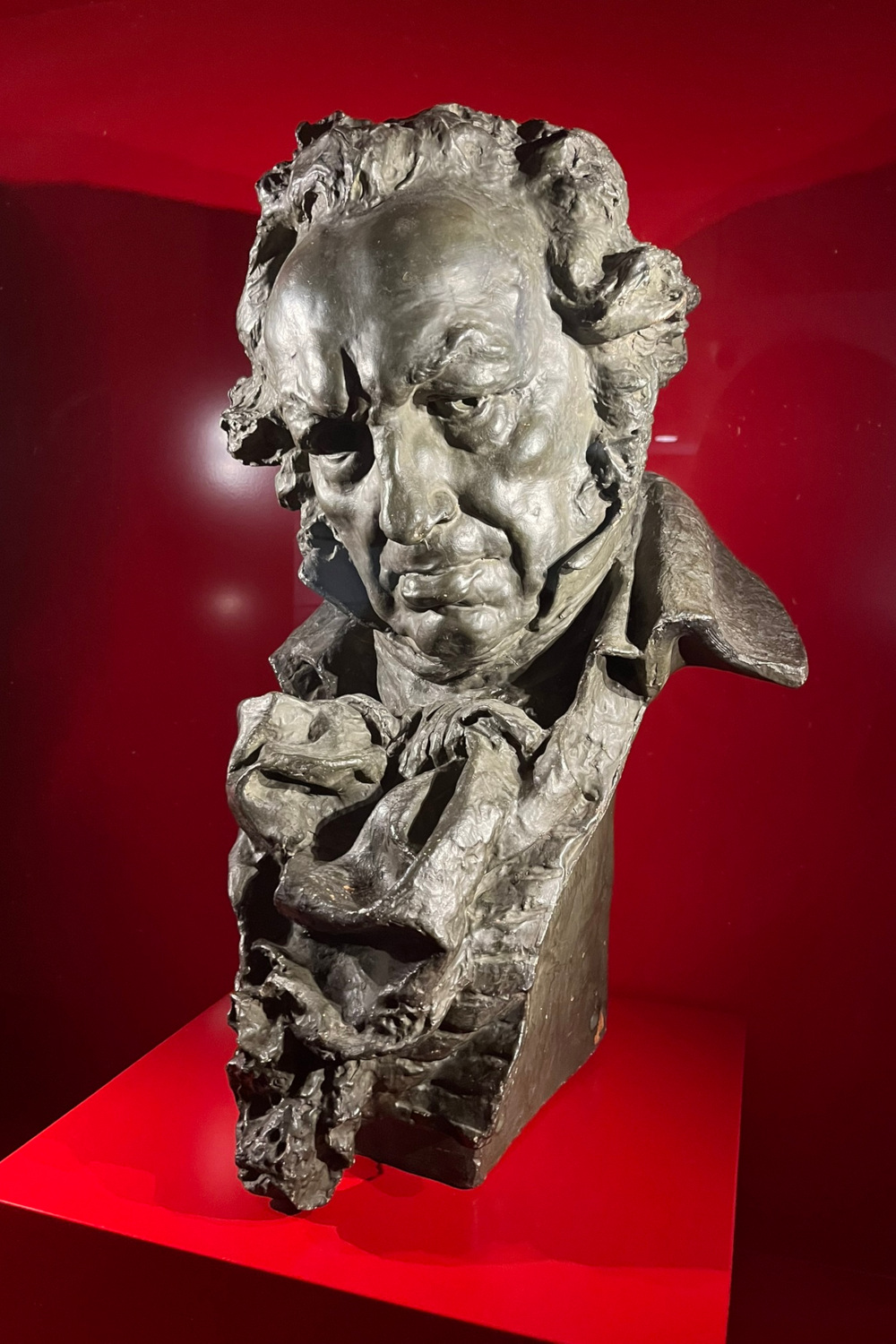
A bust of Goya, currently located in the Aljafería Palace
Less than an hour’s drive (or train ride) from Zaragoza is Huesca, a beautiful city that shares in the region’s mish-mash of modern-historical architecture. Formerly the capital of Aragon in the Middle Ages, the city is now a bubbling hub where tourists can experience authentic Spanish culture (typically without the crowds).
A different kind of history, however, can be found at Ultramarinos La Confianza, Spain’s (and possibly Europe’s) oldest grocery store. Founded in 1871 by French grocer Hilario Vallier, La Confianza has been a family-owned business for four generations – with the fifth already working the tills.
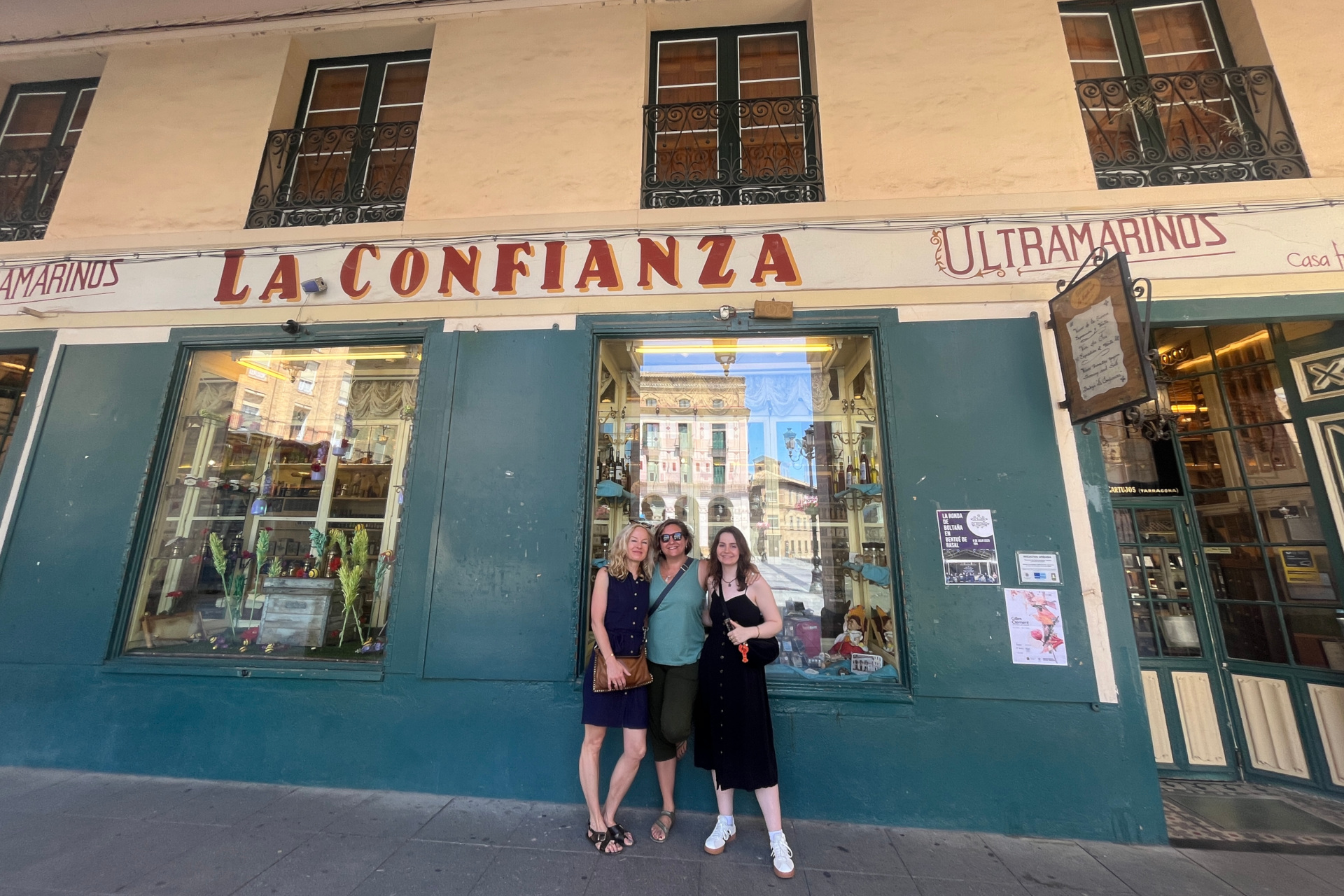
Charlie (right) at Ultramarinos La Confianza
Armed with all the charm of a vintage time capsule, visitors are greeted with a brightly painted facade decorated with old-timey typography. And the same vintage eclecticism extends to the shop’s interiors: old movie posters, family photographs dating back decades and quirky curios line the walls, while the ceiling features a series of painted frescos by local artist León Abadías, also dating back to the 19th century.
And downstairs, it only gets better (if slightly weirder). The store’s current owner, María Jesús Sanvicente, tells us that only paying customers are allowed to brave the stone steps into the grocery store’s basement, where, to our surprise, we found an enormous collection of puppets and dolls. While most remained stationary, a number were hooked up to sing, dance and light up in a grand animatronic performance. (The top recommendation is to grab some chocolates from upstairs, before settling in for the show.)
But it’s in the basement that we get a very small first look at our next destination: the Abbey of San Pedro el Viejo. One of the oldest churches in Spain, the abbey is just a 10 minute walk away from La Confianza – and the two are connected underground. (Although you’ll have to go up and out the long way to get there properly; no shortcuts here). The Romanesque structure once housed a Benedictine monastery – with the building itself dating all the way back to the 11th century – and contains the tombs of two former kings of Aragon: Alfonzo I, known as the Battler, and his brother, Ramiro II, who was also a monk of the order.
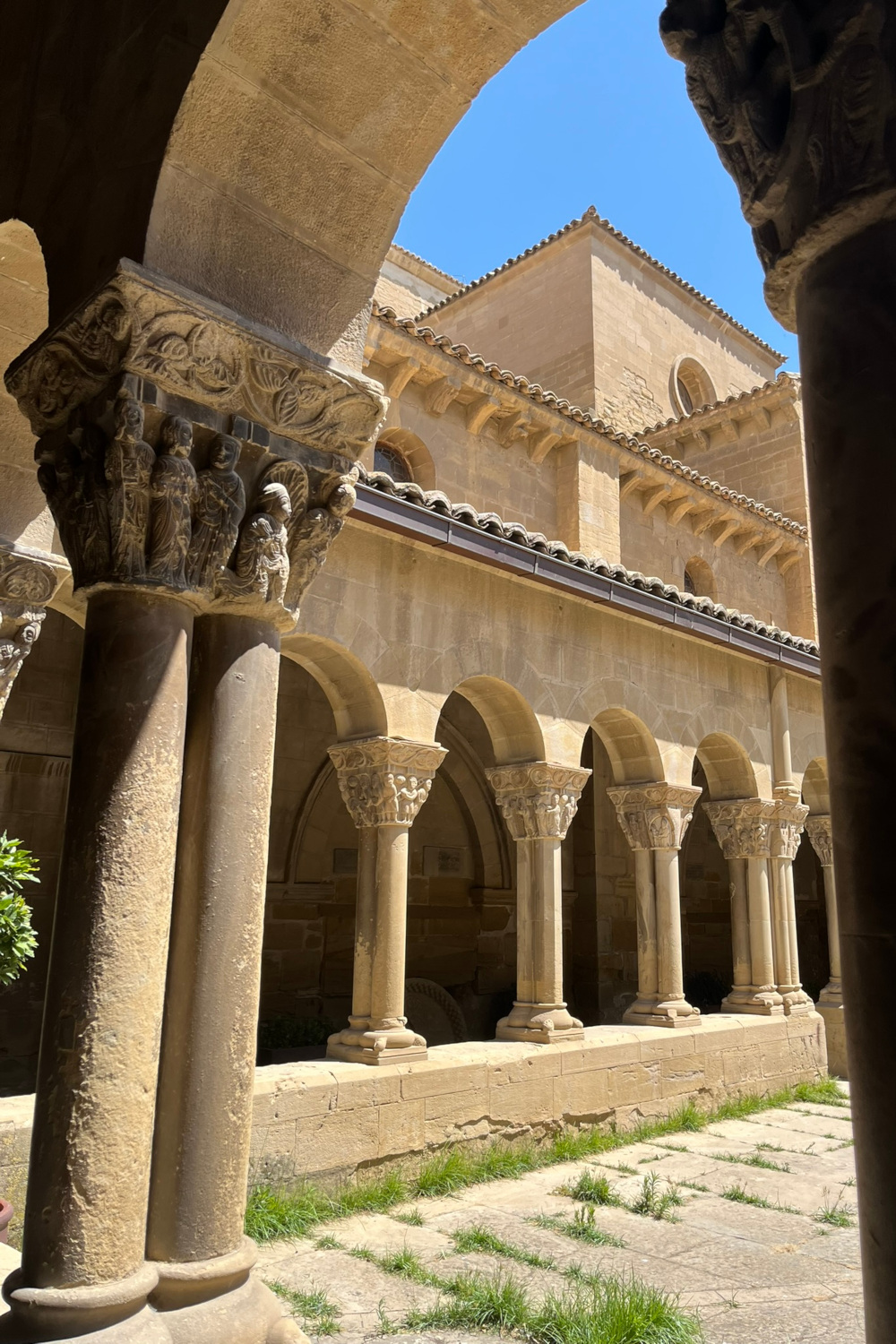
The cloisters at the Abbey of San Pedro el Viejo
Today, the abbey is both a working church and heritage site, with visitors welcome to explore its cloisters, 13th century murals (rediscovered in the 1950s) and multiple ornate altarpieces decorated in Gothic, Renaissance and Baroque styles.
From here, the city is yours to explore – but if you need a breather from the busy streets, look slightly further afield to Loarre Castle. This is one of the oldest castles in Spain (like the abbey, the castle structure dates back to the 11th century) and sits outside Huesca’s urban hub on a rocky outcrop in the hills.
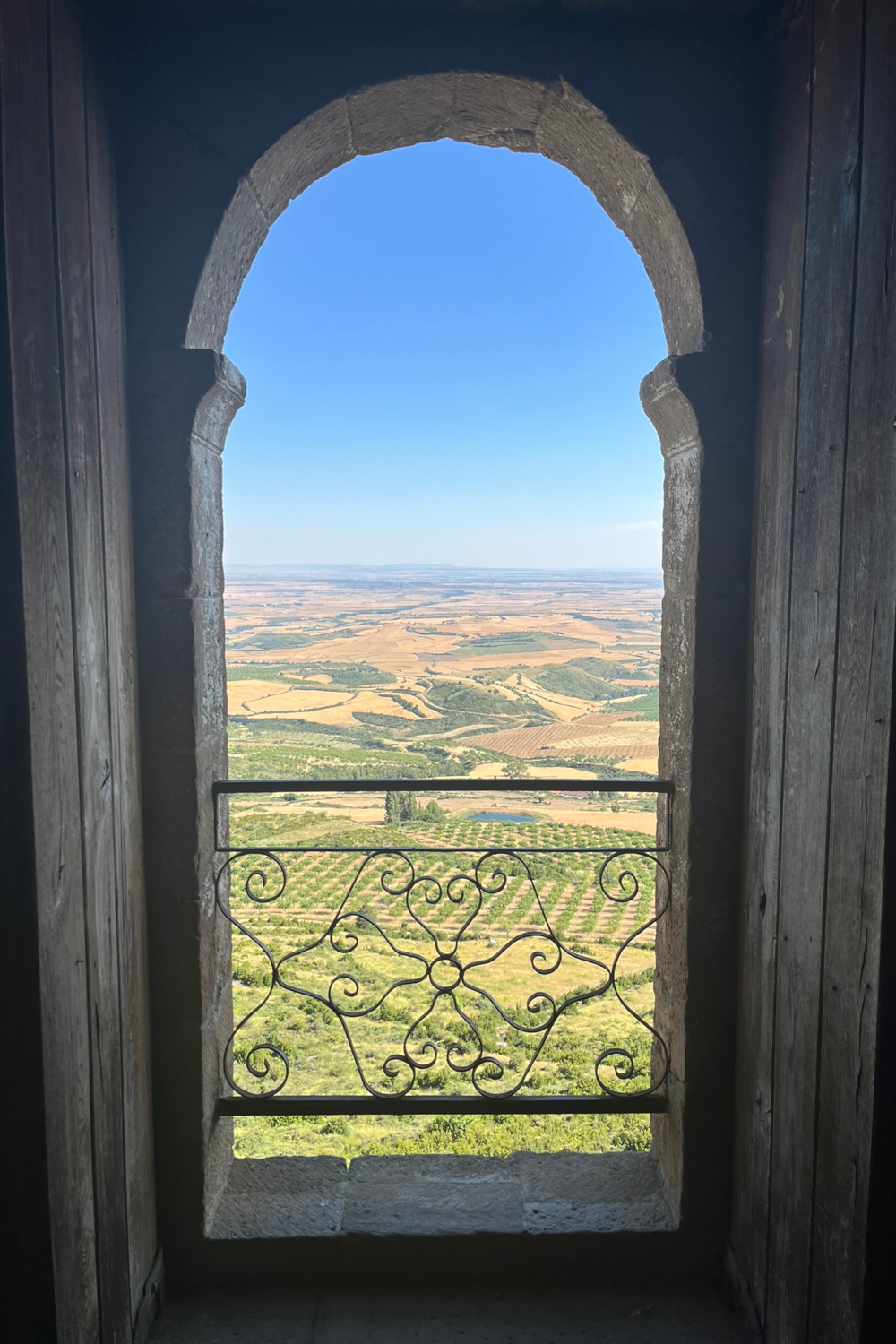
The view from Loarre Castle
Its Romanesque architecture might be familiar to some – the castle was the backdrop for 2005’s Kingdom of Heaven – but for those new to Aragon’s cultural sites, it’s a great introduction to the region’s history. Climb the steep steps, explore the cavernous innards (once home to monks, soldiers and kings) and catch the spectacular views over the Spanish landscape. And, of course, make sure to snap a photo of the impressive Baroque facade, which has been kept pretty pristine thanks to a series of recent restorations.
EAT
And if the cultural offering wasn’t enough, the foodie heritage of Aragon should be more than enough to sway your holiday destination priority list.
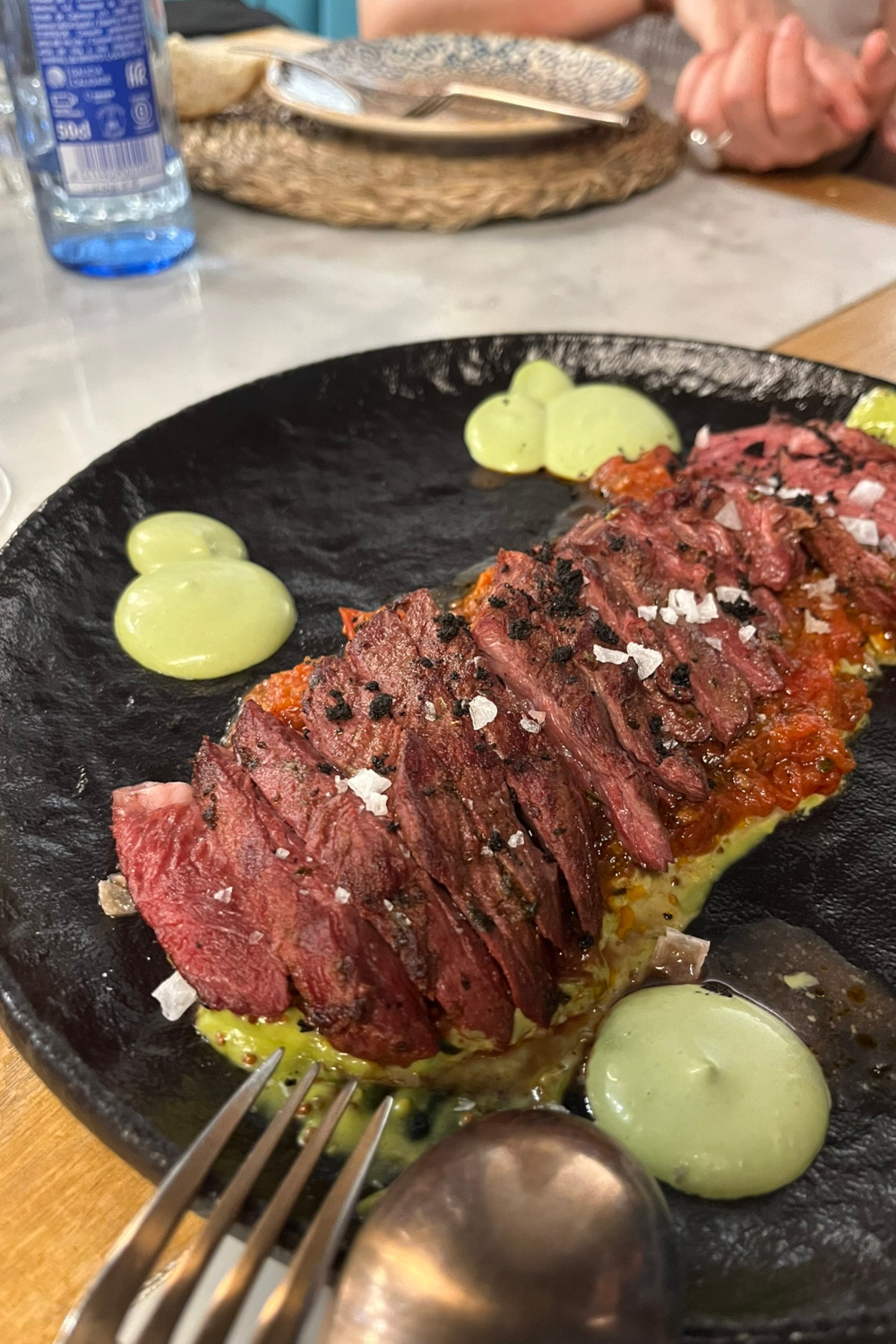
Tender steak at Restaurante Flor de Lis
During our stay, we visited three foodie spots that are reportedly a hit with the locals – and, this writer can confirm, a hit with the tourists too. First up was Restaurante Flor de Lis, a Zaragoza hotspot that served up traditional dishes with a twist. Be sure not to miss the charred cod, sausage risotto and tender sliced steak, or the bowls of crisp tomato salads, fried artichoke and peach ice cream (playfully served in matching food-shaped bowls).
Come dinner the next night, it was over to Restaurante La Clandestina, a chic dining destination in the city’s historic centre. Chef and owner Susana Casanova creates dishes that combine the best of local products with a global approach, championing a ‘slow food’ philosophy that translates into playful dishes fortified with rich Aragonese flavours. Think red prawn carpaccio with fruit brunoise and yuzu caviar, confit leeks dressed in monzón mustard and smoked teruel cheese, and lamb ‘marbles’ served with Aragon rice and a coconut curry sauce.
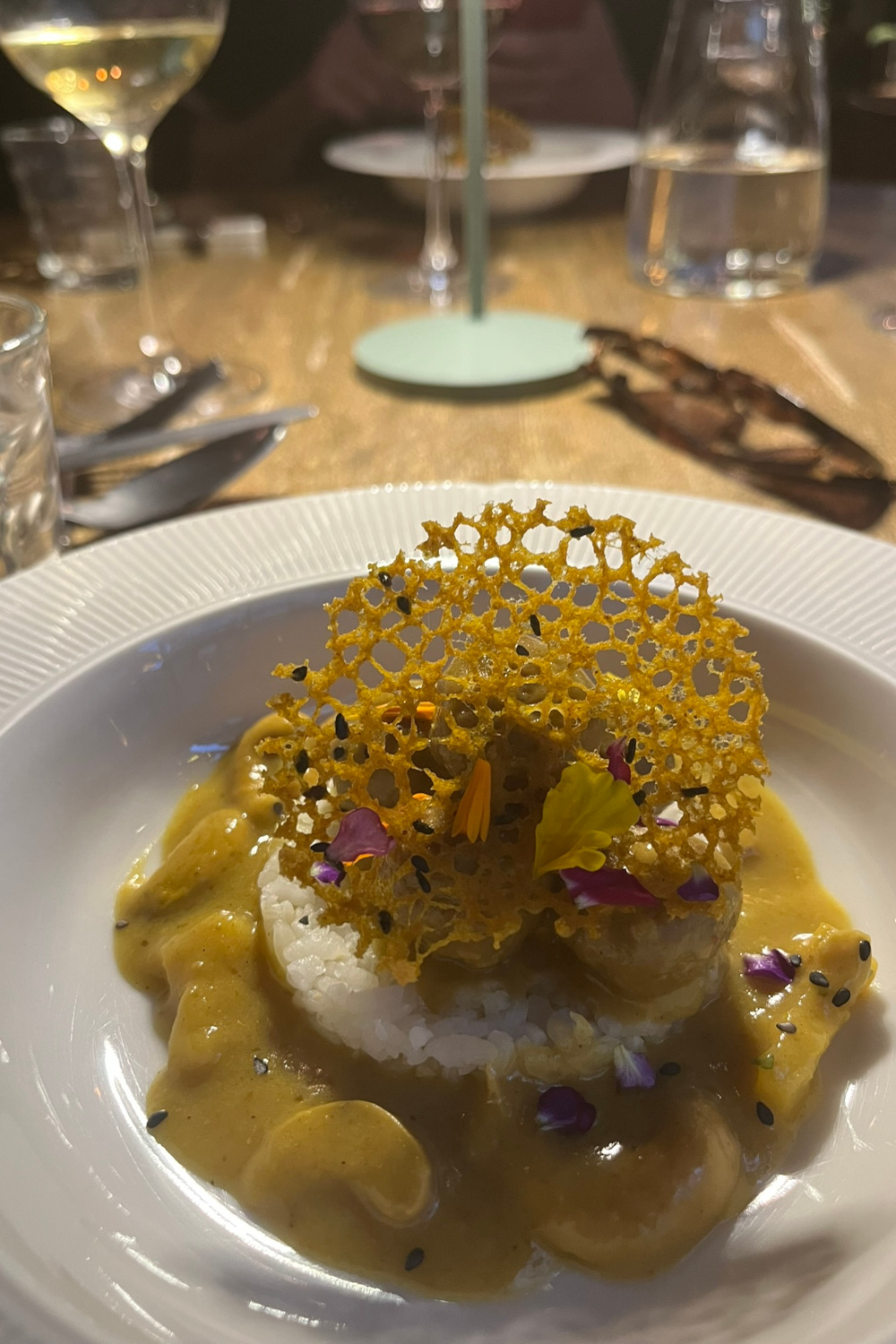
Elevated local flavours take centre stage at Restaurante La Clandestina
Our third and final destination was Basho Café, a laidback gastro bar that boasts an all-day dining offering spanning brunch, dinner, cocktails and more. This is the place to go when the weather heats up (and in summer, temperatures can easily hit 40℃ in Zaragoza), as you can spread out in either an air conditioned booth or take to some people watching at one of the tables outside. You can quite happily tuck into a cold, crisp salad, perfectly seasoned roasted vegetables and soft breads – as well as a generous slice of basque cheesecake served with a dollop of cream and caramel sauce.
But if tapas is more your speed, make sure to take a stroll down El Tubo – Zaragoza’s famous tapas alley, filled with acclaimed eateries renowned for their elite small plates. Come evening, you’ll find the alley filled with people, comfortably crammed into restaurants and sprawling across chairs and tables scattered through the street. And with a host of wine bars just a short walk away (you’re never too far from one in Zaragoza), it’s easy to let the evening extend well into the early hours of the morning.
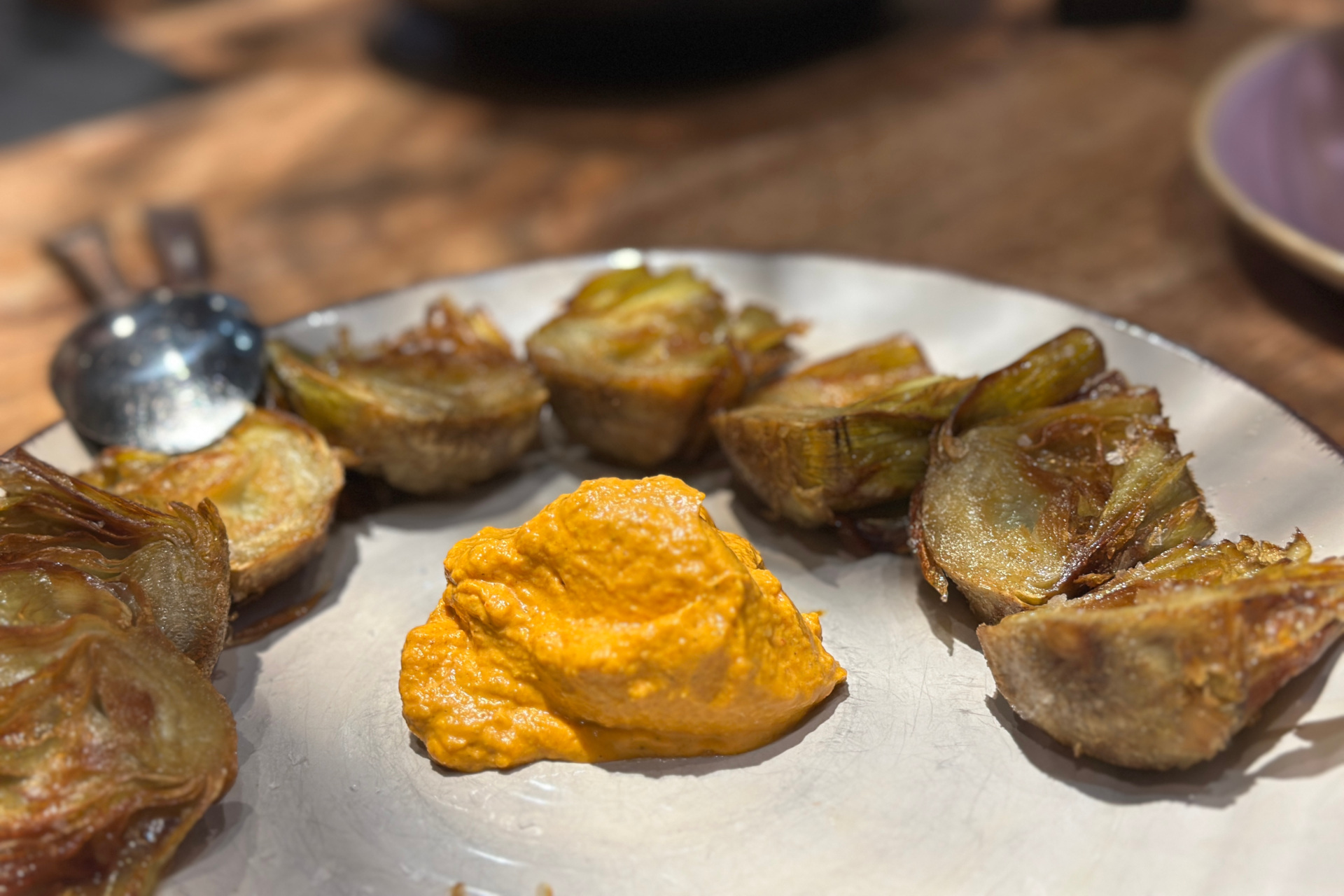
Fried artichoke and dip at Basho Café
(As a coeliac diner, I was initially apprehensive about whether restaurants would be able to cater for a gluten free diet – but found myself pleasantly, if not joyfully, surprised by the long list of options. There’s even a guide to Zaragoza’s gluten free dining options on the Aragon Celiac Association website, here.)
During the daytime, however, there’s also the city’s famous market hall to explore. Like much of the city’s architecture, the Mercado Central de Zaragoza building comes with plenty of history. The building was designed by Aragonese architect Félix Navarro Pérez at the end of the 19th century, and replaced the old market square when it was completed in 1903 – but really, it’s what’s inside that calls out to passersby today.
The bright, open space (lit by glass walls and vast skylights) is lined with food stalls: locally picked fruit and vegetables, freshly caught fish, prime cuts of meat, fragrant cheeses and rows on rows of sweets (including Frutas de Aragón, candied fruits covered in chocolate). The market thrums with activity, even on a weekday afternoon, with locals and tourists alike shopping from the treats on offer. (Our tour guide even points out a group of regular women, who he says like to come to the market on a daily basis for a drink, a pastry and some gossip).
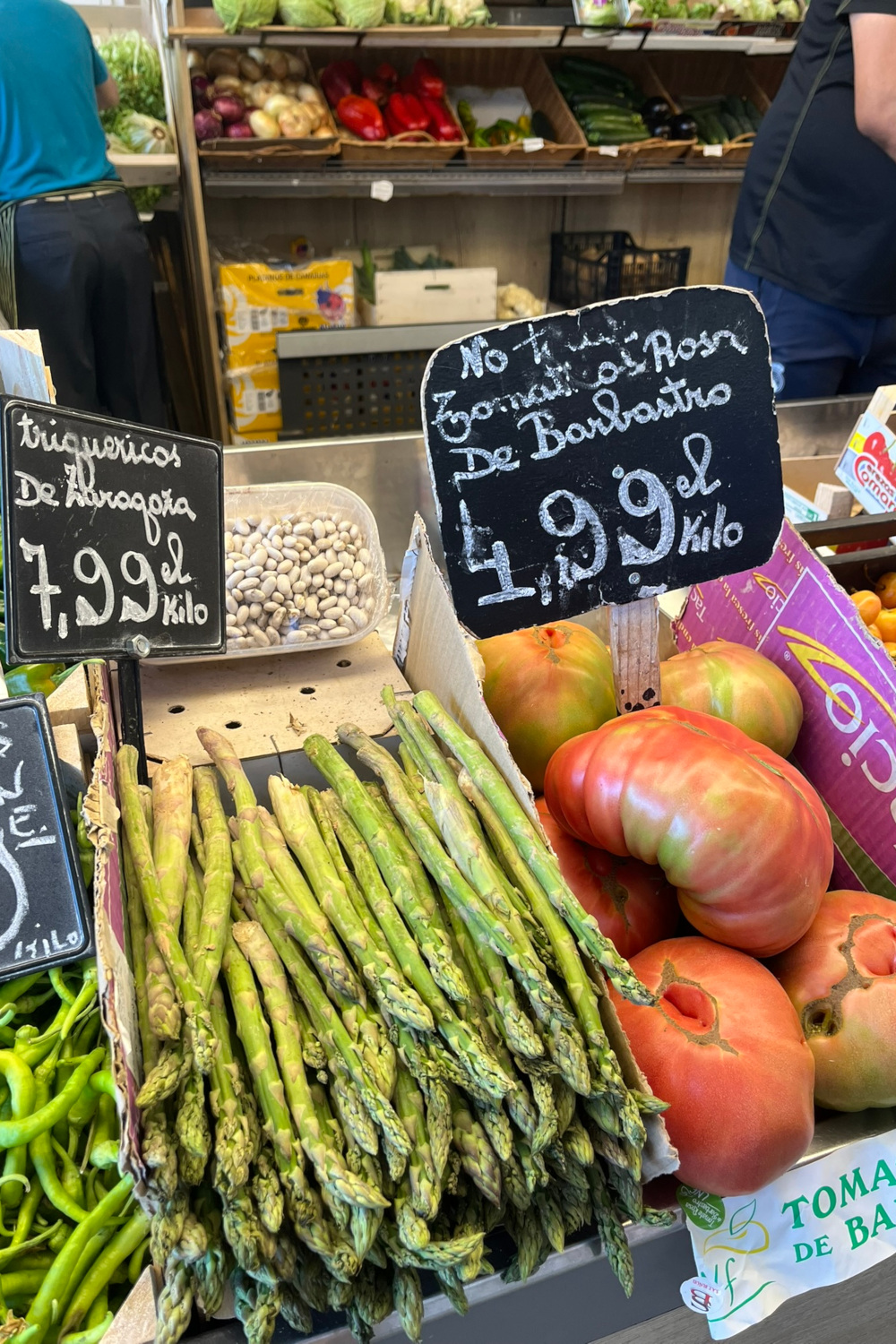
Fruit and vegetable stalls at Mercado Central de Zaragoza
The market is also the perfect starting point for our next activity: a cooking class at La Zarola, one of Zaragoza’s go-to gastronomic event spaces. About a 15 minute walk from the market, it’s a quick trip from one to the other (and enough time to get tummies rumbling for another meal).
La Zarola’s sleek kitchen sees workbenches complete with built-in hobs take up the central space, bracketed by ovens, cupboards (holding an impressive army of tools), sinks and refrigerators along the walls.
We clamber onto stools and peer hungrily at the dishes we’ll be making: caramelised onion and goat’s cheese parcels with Garnacha caramel, chilled almond soup with smoked sardine and red wine gelatin, pork cheeks cooked in Garnacha red wine with potato and apple parmentir, and pears soaked in white wine with almond crumble and Chantilly cream. (Local Garnacha wine, which plays a starring role in the menu, also makes an appearance in the wines selected for each dish).
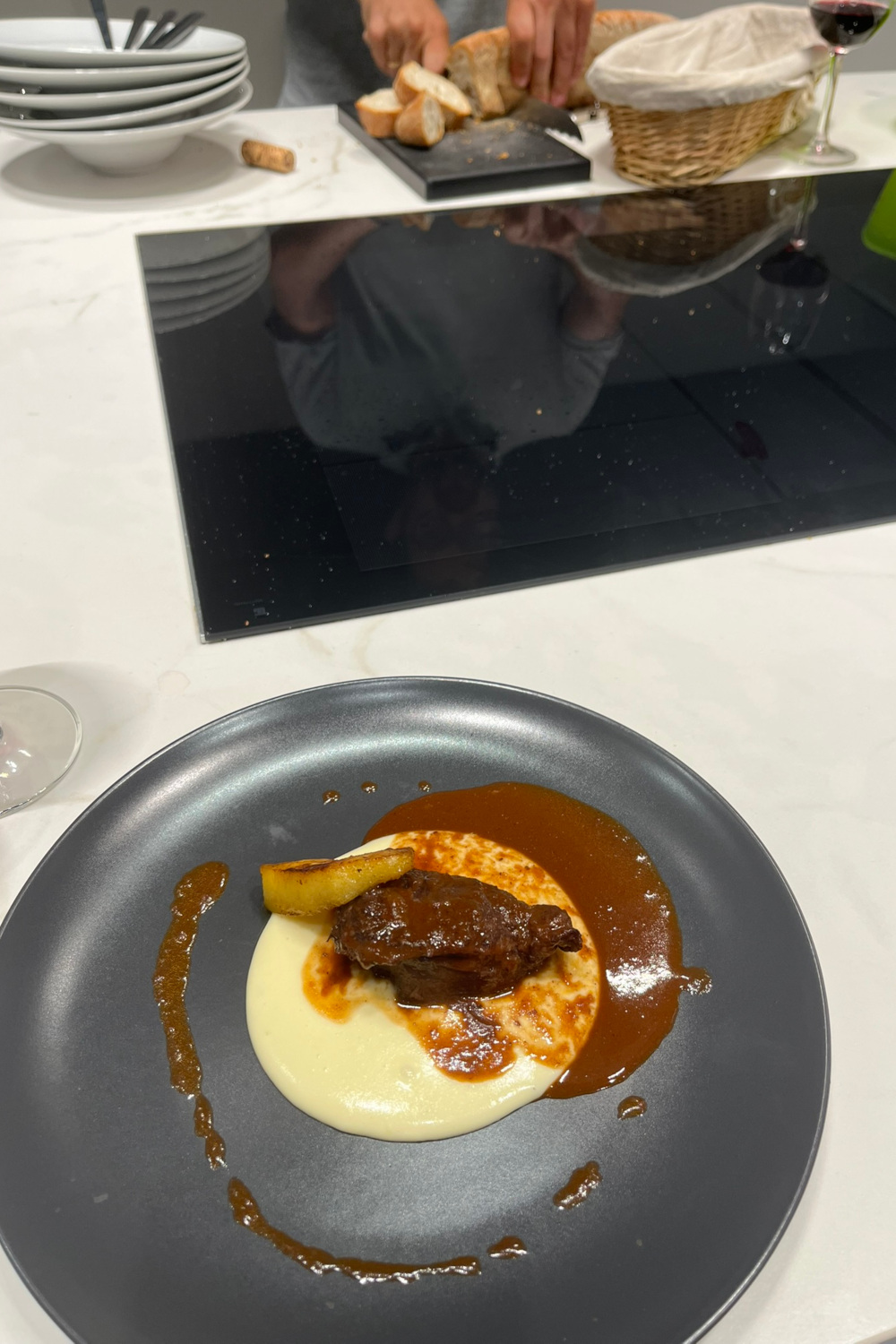
One of the dishes we helped make at La Zarola
Following the lead of our head chef, we got stuck in – folding parcels, stirring pots and (perhaps the easiest part of the class) pouring generous glasses of wine. But the (not very) hard work pays off when each dish hits the table. The indulgent offering showcases Zaragoza’s speciality in authentic Spanish flavours, and each bite leaves the table feeling thoroughly satisfied (and happily full).
(And if you’re keen to try one of La Zarola’s dishes for yourself – ahead of your trip to Zaragoza, of course – have a flick through its online recipe book here).
In Huesca, meanwhile, you’ll find Michelin-starred restaurant Lillas Pastia. Specialising in seasonality and headed up by chef Camrelo Bosque, the restaurant was awarded its Michelin star over 25 years ago, making it the longest-held star in the region.
The restaurant celebrates some of the richest flavours Aragon has to offer – especially black truffle, an ingredient for which this part of Spain is well known and praised. You’ll find that black truffle takes a prime seat in front of the kitchen window, stacked high in silver bowls, as well as on the plates of hungry visitors.
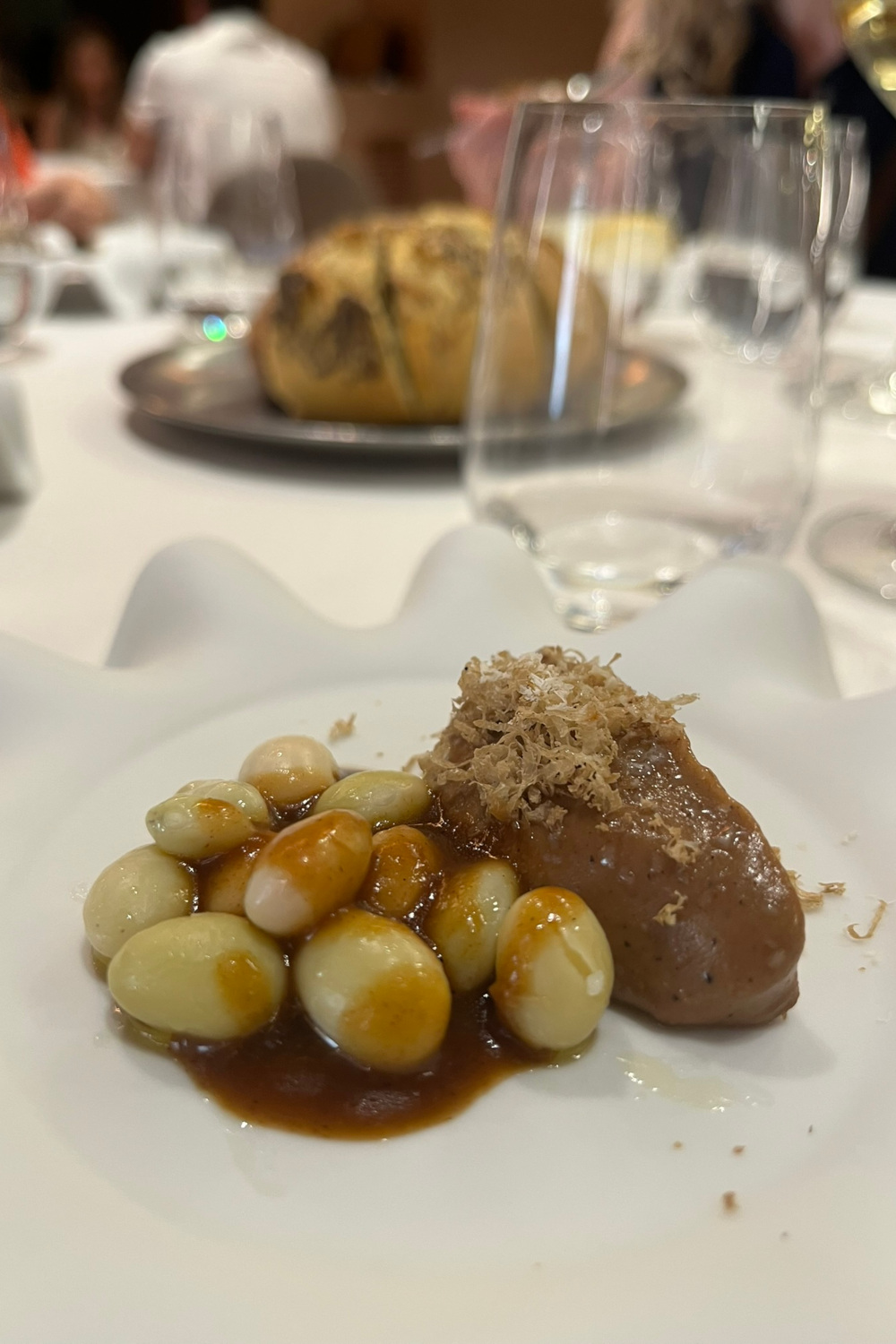
You can’t visit Huesca without a visit to the Michelin-starred Lillas Pastia
Another speciality of Lilla Pastia’s is its tasting menu, which shifts throughout the year to better accommodate the freshest ingredients. We dropped in to the restaurant’s lunchtime tasting menu, a 15-course spectacular crafted around light bites that show off the region’s local flavours. Think truffle-topped artichoke, creamy risotto, gravy-soaked beans and a huge selection of pastries and sweets.
But if you really want to get a taste of Aragon, then you’ll need to get your hands on a bottle of Garnacha. Otherwise known as Grenache, this flavourful wine comes from a particularly hardy grape variety that tends to thrive in harsher environments – like the mountains and hills surrounding Zaragoza. This is where the Garnacha grape is believed to have originated, and where wineries still grow it today.
You can find pages-long Garnacha wine lists in most (if not all) of Zaragoza’s restaurants – but you can also go to the source itself. There are plenty of bodegas in the surrounding hills you can visit (most of them by a handy bus tour service, like this one). Our trip took us to two of Aragon’s biggest wineries: Bodegas Borsao and Bodega Tierra De Cubas.
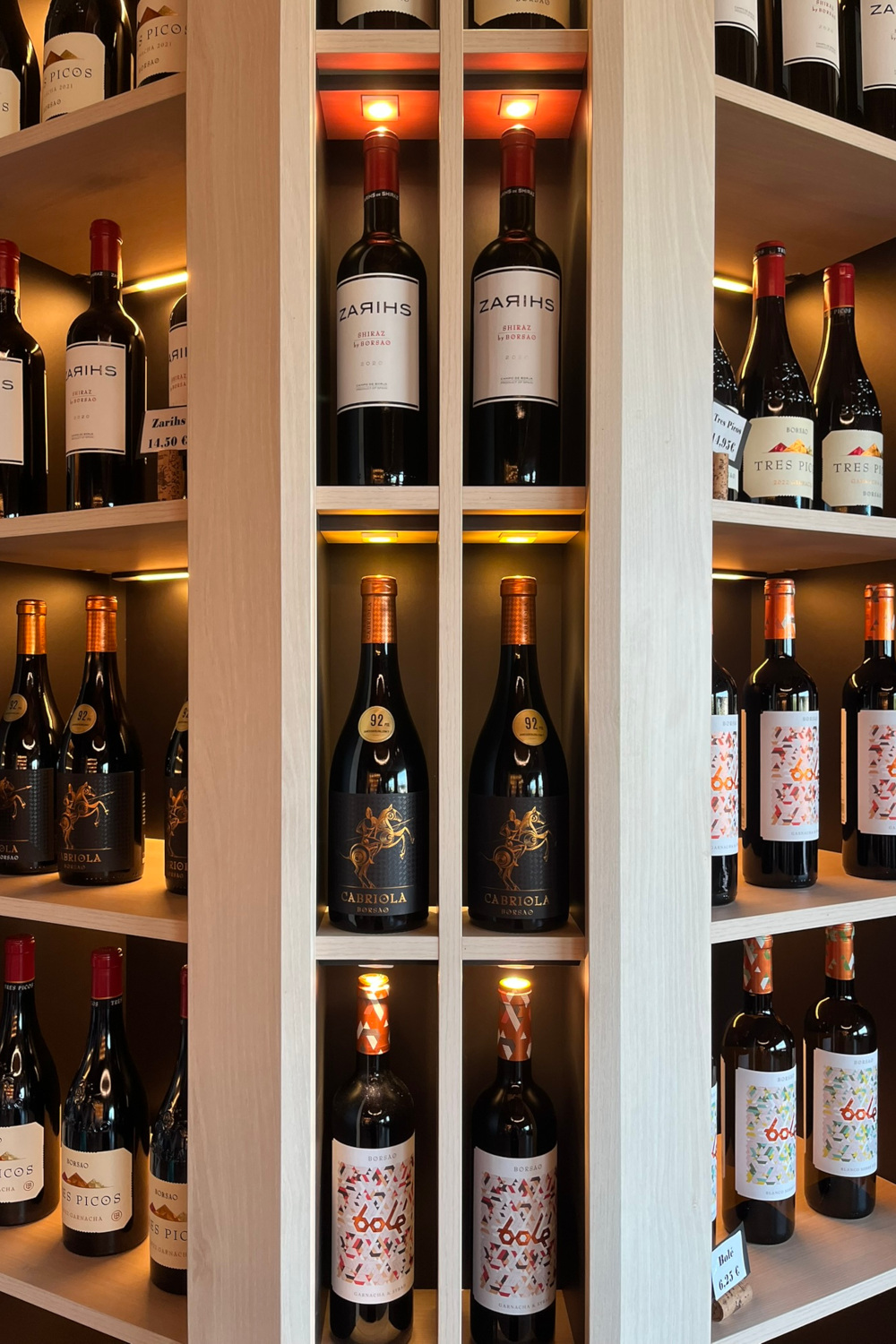
Bodegas Borsao is one of Aragon’s most famous wineries
The Borsao winery sits at the foot of the Moncayo mountains, just northwest of Zaragoza. Originally founded as a cooperative back in 1958, it took on the title of Bodegas Borsao in 2001 after merging with two other cooperatives – and, with over 70 percent of its vineyards dedicated to Garnacha grapes, it’s now one of the most well-respected Garnacha producers in Aragon.
Tierra De Cubas is similarly held in high esteem. Part of the Bodegas San Valero group, the bodega is surrounded by fields of vines growing the grapes for its next vintage (usually Garnacha, but Tierra De Cubas also makes a delicious cava).
At both venues, we were treated to an extensive wine tasting (complete with local cheeses, olive oils, bread and cuts of meat), as well as a tour of the bodegas. Walking through the process of creating a bottle of wine – including the drinks in our hands – via the vineyards and rows of vats and barrels, these hotspots are true havens for a globetrotting foodie.
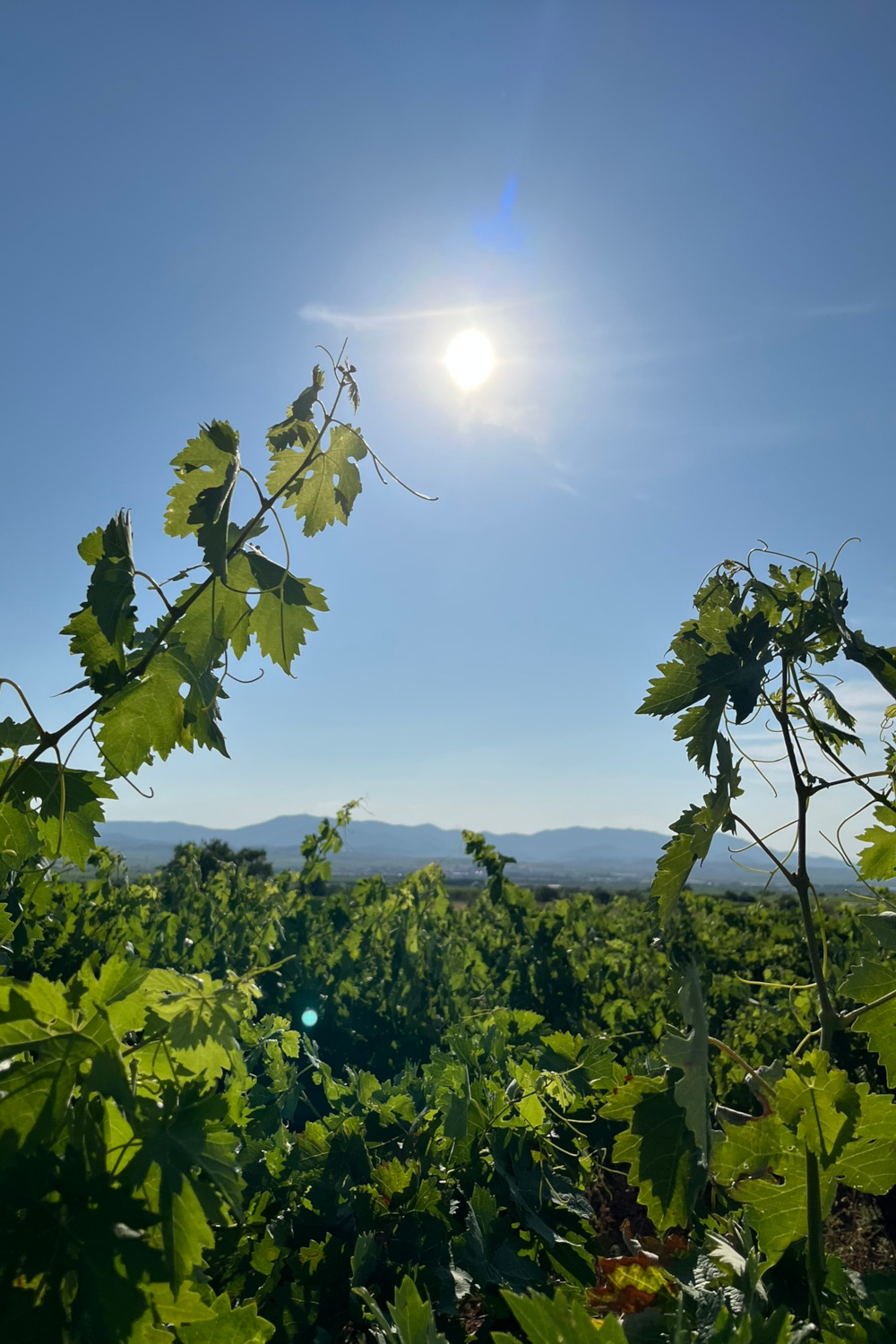
The vineyards at Bodega Tierra De Cubas
STAY
The wine tour doesn’t necessarily have to come to an end, however – especially if you find yourself at Bodega Tierra De Cubas.
Alongside its thriving winery and restaurant, the bodega is also home to a small number of residential suites. The unassuming building, perched above the main winery, has some fantastic views stretching out over Cariñena (and the bodega’s many grape vines). It’s well worth braving the balmy summer heat for a chance to see the sunset, or the sunrise if you can manage the early start.
And once you return to your room – a sizeable space with enough modern amenities to make a hotel suite jealous – it will be to find a plush bed and a side table filled with snacks and drinks. (Perfect for those post-wine munchies.)
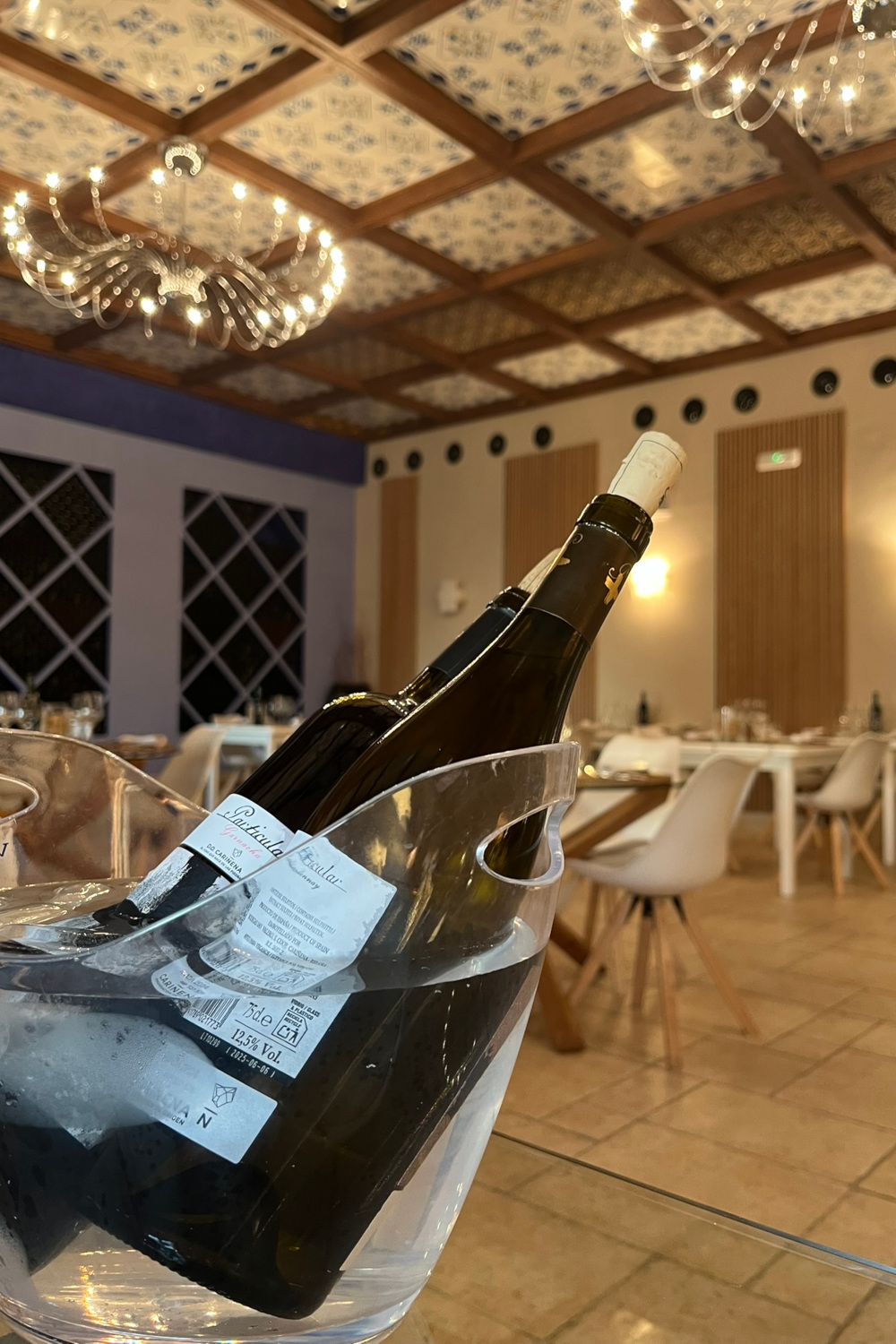
Bodega Tierra De Cubas is also home to rooms and a restaurant
But if you’d prefer to keep base in the buzzing streets of Zaragoza, check in to the city’s chicest stay: Hotel Avenida. This boutique hotel lures in busy vacationers looking for a luxe escape – especially after spending the day exploring the city on foot, or wining and dining your way through the region.
And, stepping through its glass doors into the softly lit reception, it’s clear to see why Hotel Avenida has amassed such a reputation. Designed in a fusion of Mediterranean and Japanese interior styles, a rich minimalism lines every corner of the space. Organic materials, raw textures and neutral hues are brought to life through a detailed study of light. It’s calm – and, more importantly, quiet – contrasting with the fast pace of the city outside.
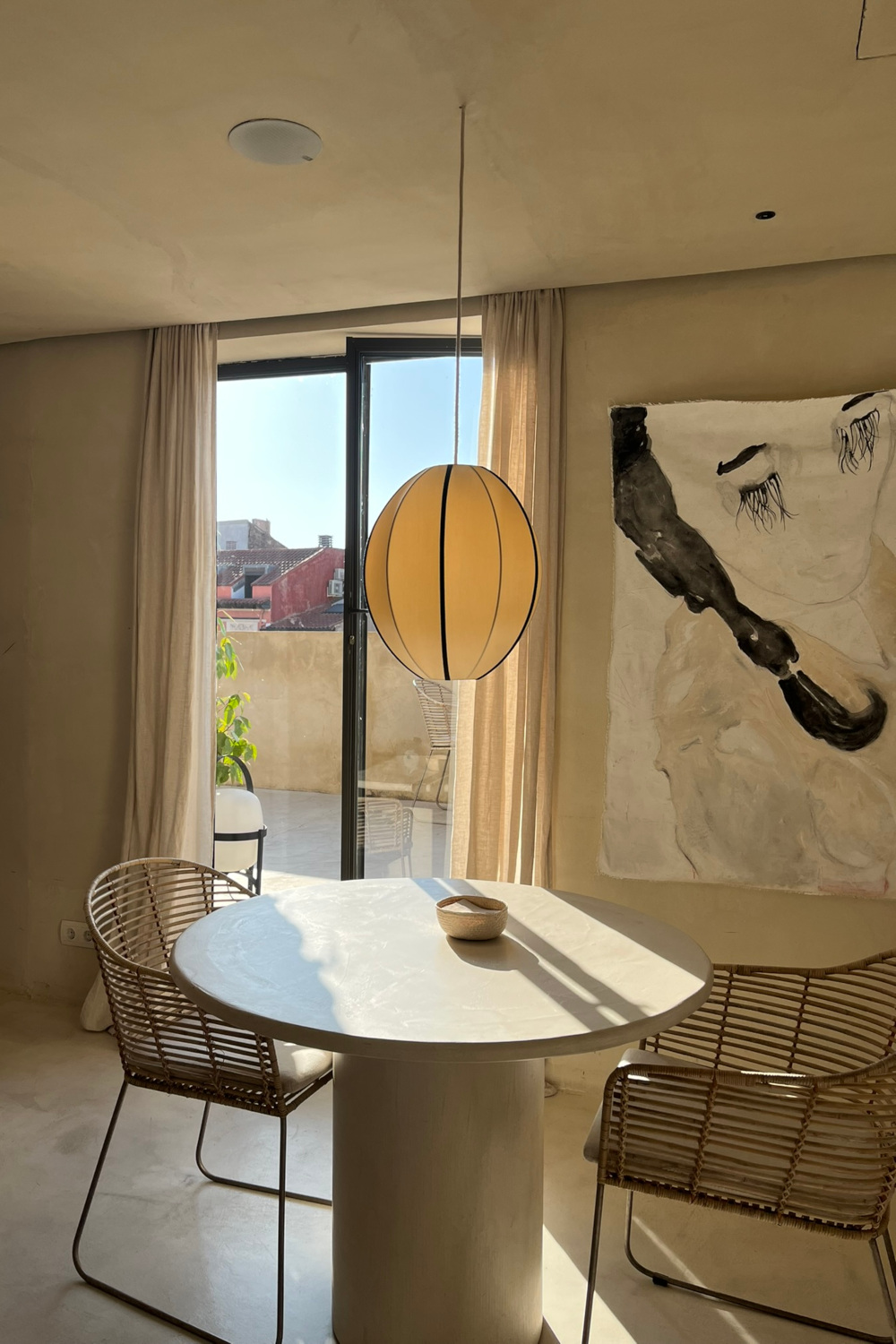
Cream colour palettes and chic minimalist interiors characterise the Hotel Avenida experience
‘To me, true luxury is a space that doesn’t overwhelm, but rather embraces those who enter it,’ says Carmen, the interior designer behind Hotel Avenida. ‘The guest is invited to be present, to slow down, to enjoy the silence.
‘From the very beginning, I wanted to create an atmosphere that was not only aesthetically harmonious but also invited introspection,’ she continues. ‘A space that would act as an emotional refuge, where guests could reconnect with themselves, breathe more calmly, and experience a true sense of wellbeing.’
The same design principles shape the suites and rooms throughout the hotel. A creamy colour palette softens any hard lines and rough textures, with hazy light filtering through gauzy curtains illustrated with painted female figures – who stretch lazily across the fabric in a way that encourages the room’s occupant to stretch their own muscles and relax back onto the enormous, pillowy bed.
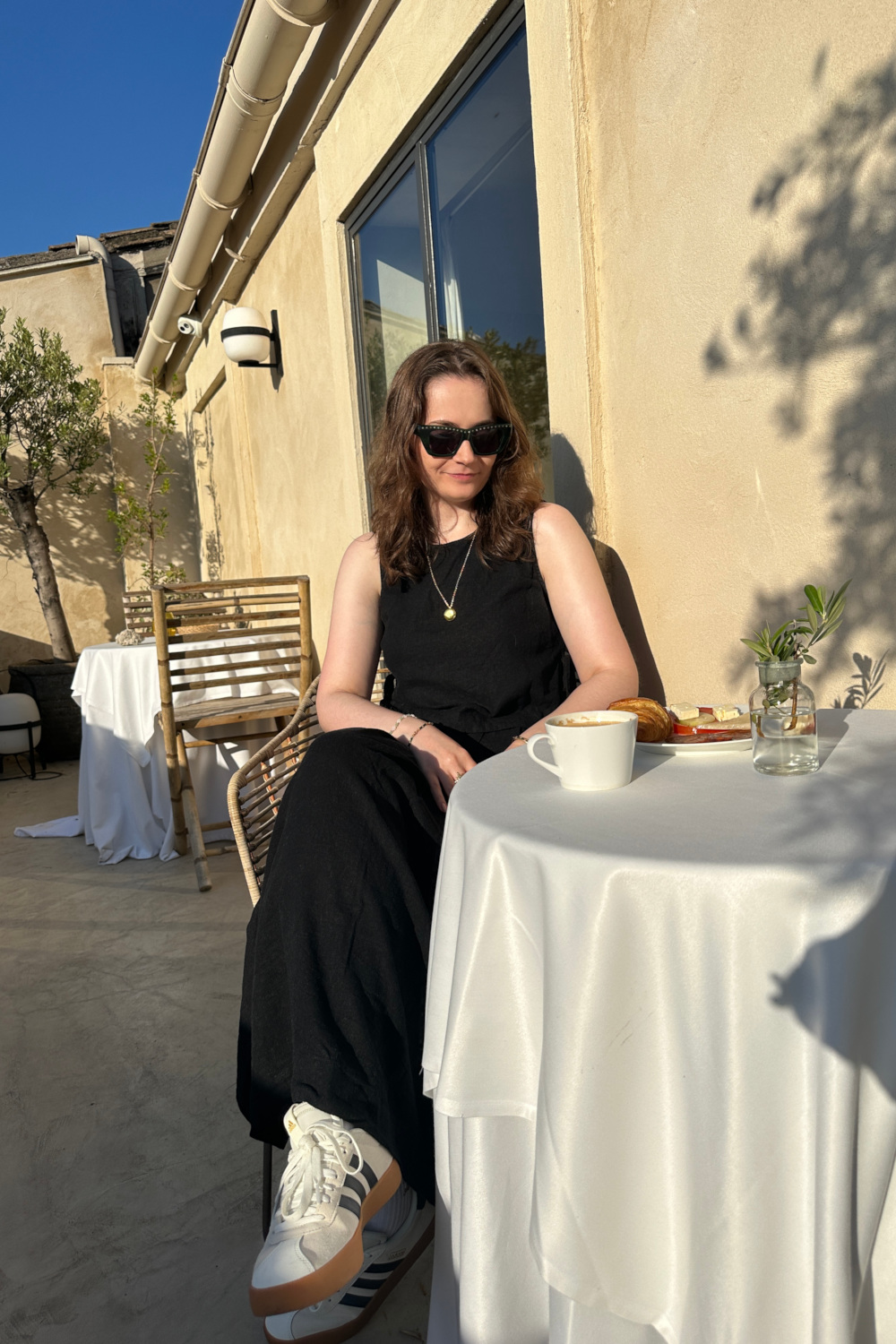
Charlie enjoying breakfast on the balcony at Hotel Avenida
Some suites – like ours – even come with a freestanding tub, overlooking both the bedroom and the city streets below. It just about outshines the rainfall shower and twin sinks in the bathroom next door, pulling guests in with the temptation of a hot soak (complete with Hotel Avenida’s stash of sweet-smelling toiletries).
It’s all too easy to sink into the pillows and drift away for the evening. But a morning at the hotel is not to be missed. While you might find most of your evenings spent exploring Zaragoza’s foodie scene, Hotel Avenida’s breakfast spread is well worth staying in for. Taken on the top floor – and, weather permitting, the terrace balcony – the first meal of the day is a curated buffet of warm pastries, diced fruits, cheeses and meats. (Plus plenty of coffee). The hotel chooses local suppliers for its culinary offering (and with the Mercado Central just down the road, it’s not a difficult task), ensuring that everything tastes as fresh as possible.
The Final Word
Aragon feels like Spain’s best kept secret. The perfect collision of history and culture, city and countryside – yet to be disrupted by even the thought of mass tourism. This is Spain at its most authentic. And while it’s tempting to gatekeep the colourful streets of Zaragoza, Huesca’s rich heritage and the region’s rolling vineyards, it deserves to have its time in the spotlight. So, when you next make plans to visit La Piel de Toro, make sure to dig a little deeper. You never know what you might find.
turismodearagon.com | spain.info
Charlie’s return flights from London Heathrow to Madrid and return trains from Madrid to Zaragoza had a combined carbon footprint of 423.7kg of CO2 e. ecollectivecarbon.com

